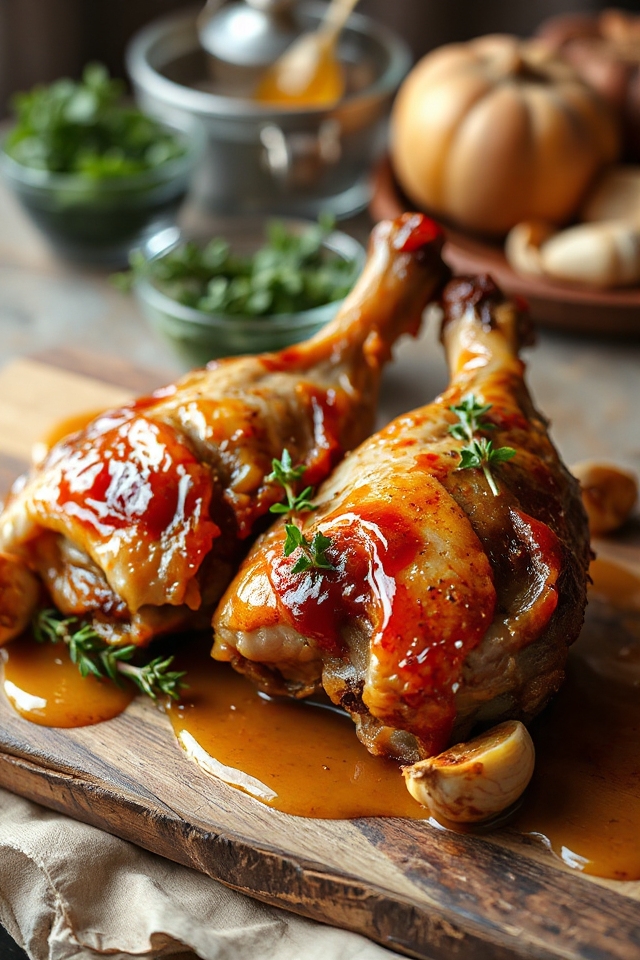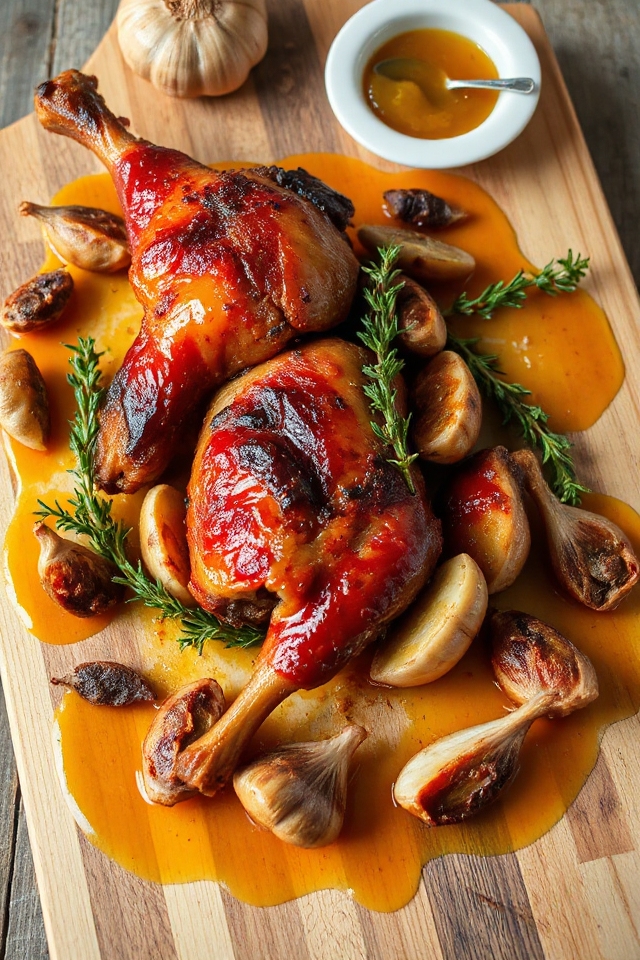Why You’ll Love This Duck Confit Recipe
Have you ever tasted something so rich and flavorful that it instantly transports you to a cozy bistro in France? That’s exactly what Duck Confit does for me.
The tender meat practically melts in your mouth, enveloped in a heavenly layer of golden, crispy skin. It’s more than just a dish; it’s an experience that awakens your senses.
I love how easy it’s to prepare, yet it feels so indulgent. Whether you serve it with a fresh salad or a side of potatoes, each bite is a celebration of flavors that’ll have you dreaming of Paris long after the meal ends.
Ingredients of Duck Confit
When it comes to crafting the perfect Duck Confit, having the right ingredients is key. While it may seem like a decadent dish reserved for special occasions, the truth is, with a little planning and a few simple ingredients, you can recreate this French delicacy right in your own kitchen.
Let’s explore what you’ll need to make this mouthwatering meal happen.
Ingredients for Duck Confit:
- 6 duck legs
- 30 g kosher salt (per kilo of meat)
- 30 garlic cloves
- 8 cups rendered duck fat (or pork fat)
- 1/2 teaspoon ground allspice
- 1/4 teaspoon freshly ground nutmeg
- 2 bunches fresh thyme (or 1 bunch if you prefer)
- 6 bay leaves
- 1 tablespoon white wine vinegar (or lemon juice)
- 3 tablespoons oil (olive, corn, sunflower, walnut, or a mix of your favorites)
- 1 teaspoon Dijon mustard
Now, you might be wondering if all these ingredients are absolutely necessary. It’s a great question.
The salt and fat are essential for the confit method, which preserves the meat and makes it so tender. The garlic, thyme, and spices? They’re the magic that infuses flavor, turning ordinary duck into something extraordinary.
Don’t skimp on the fat, though; it’s what gives the duck its signature texture and taste. And if you can’t find duck fat, pork fat is a solid alternative.
Just remember, the quality of your ingredients will shine through in the final dish. So, while you can substitute here and there, sticking close to the original lineup will help you create a Duck Confit that would make any French chef proud.
Now, get ready to roll up your sleeves and prepare for some culinary magic.
How to Make Duck Confit

Making Duck Confit might sound a bit intimidating at first—what with all the fancy French names and ingredients. But trust me, it’s not rocket science, and the end result is worth every minute spent. So, let’s explore the process of transforming those 6 duck legs into a melt-in-your-mouth masterpiece.
First things first, you’ll need to start the curing process. Grab your 30 g of kosher salt and mix it with 1/2 teaspoon of ground allspice and 1/4 teaspoon of freshly ground nutmeg. Sprinkle this mix generously over the duck legs, making sure to cover them well.
Next, take those 30 garlic cloves and press them onto the duck along with 2 bunches of fresh thyme. Don’t be shy—really press them in there; we want that flavor to soak in. And how about a bay leaf for each leg? Place 6 bay leaves on the exposed flesh. It’s like dressing your duck for a fancy occasion, and honestly, it deserves it.
Then, cover the dish and let it hang out in the fridge for 24 hours. It’s like giving it a spa day, just a bit saltier.
Now, after your duck has marinated and soaked up all those lovely flavors, it’s time to cook. Preheat your oven to a cozy 200°F. Drain any liquid from your baking dish—don’t forget to pat those legs dry.
Place the duck legs back in the dish with the garlic and herbs, and then cover them completely with 8 cups of warm rendered duck fat (or pork fat if you’re feeling adventurous). Pop that dish into the oven and let it bake for a good 6 to 8 hours. Seriously, you can almost smell the magic happening.
When you finally pull those legs out, the garlic should be a lovely golden brown, and the meat should be so tender it practically falls off the bone. Let them cool in the fat, which not only keeps them moist but also transforms the dish into something extra special.
When you’re ready to serve, brush the duck with some orange marmalade and give it a quick blast in a hot oven until crispy. Voilà! You’ve just made Duck Confit like a pro. Enjoy the fruits of your labor, and don’t forget to brag a little.
Duck Confit Substitutions & Variations
Although Duck Confit is a classic dish, there are plenty of ways to adapt it to suit your taste or dietary needs.
For a lighter option, you can substitute duck legs with chicken thighs; just adjust the cooking time.
If you’re looking for a vegetarian twist, try using hearty mushrooms, like portobellos, cooked in a similar fat.
For flavor variations, experiment with spices like smoked paprika or add citrus zest to the curing mix.
If you can’t find duck fat, olive oil works well too, though it alters the richness.
Get creative and make this dish your own!
What to Serve with Duck Confit
To enhance the rich flavors of Duck Confit, I recommend serving it alongside some classic accompaniments that perfectly balance its savory profile.
A creamy potato purée or garlic mashed potatoes work wonderfully to soak up the duck’s rich fat. Roasted seasonal vegetables, like Brussels sprouts or carrots, add a nice crunch and freshness.
A simple green salad with a light vinaigrette can cut through the richness, providing a revitalizing contrast. To elevate the experience, consider a side of lentils or a fruity chutney, which complements the dish beautifully.
These pairings create a delightful and satisfying meal. Enjoy!
Additional Tips & Notes
When preparing Duck Confit, it’s essential to pay attention to the curing process, as this step deeply influences the flavor and texture of the meat.
Don’t rush; let the duck cure for a full 24 hours. If you can, use high-quality rendered duck fat for the best results.
When baking, I recommend checking the meat’s tenderness after six hours. If you’re reusing duck fat, strain it carefully to remove impurities.
Remember, you can save any leftover duck liquid for sauces—it adds great flavor!
Finally, for a crispy finish, brush the duck with orange marmalade before reheating. Enjoy!
